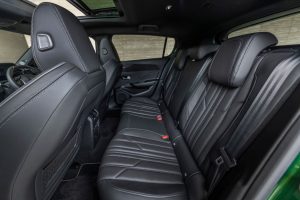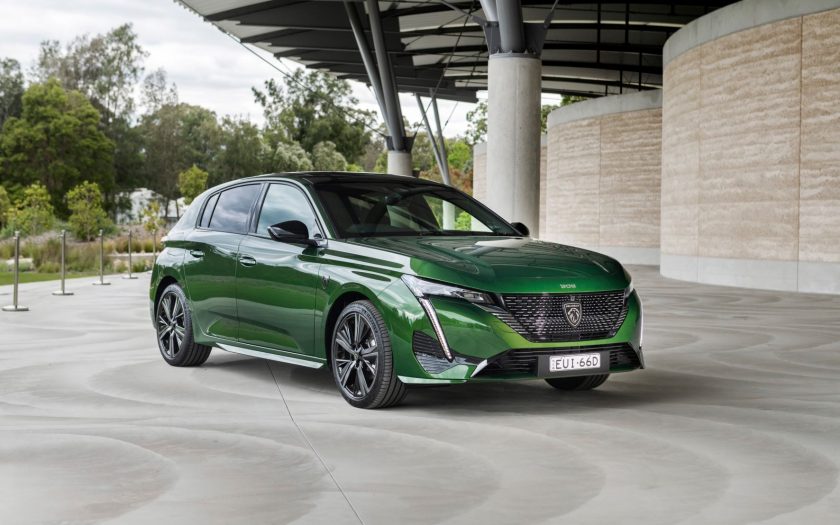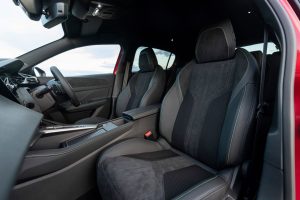Chris Riley tests the 2023 Peugeot 308 GT Hatch with pricing, specs, ride and handling, safety, verdict and everything the over-50 driver needs to know.
Summary: The Peugeot 308 GT sits outside the mainstream, and that will appeal to a lot of buyers, but the price really is too high.
2023 Peugeot 308 GT hatch
Pricing: $43,990 (plus on road costs)
Options: metallic paint $690, premium metallic paint $1050
Warranty: Five-years/unlimited km, five years roadside assist
Safety: 4-star ANCAP (tested 2022)
Build location: France
Engine: 1.2-litre turbo intercooled 3-cylinder DOHC petrol
Power: 96kW at 5500rpm
Torque: 230Nm at 1750rpm
Transmission: 8-speed sports automatic, front-wheel drive
Body: 4365mm (long); 1859mm (wide); 1465mm (high)
Weight: 1290kg
Towing capacity: 1400kg
Wheels: 18-inch alloy
Tyres: 225/405 R18
Ground clearance: 180mm
Fuel tank capacity: 52 litres
Official consumption: 5.3L/100km (95 premium RON petrol)
Consumption on test: 7.1L/100 (400km)
seniordriver consumption on test: 6.0L/100km (420km)

[review]
Third generation Peugeot 308 was unveiled in March, 2021. It went on sale here late last year.
The line-up consists of three hatches and a wagon, with a plug-in hybrid hatchback due to arrive before the end of the financial year.
308 is the first model to wear Peugeot’s redesigned badge, occupying pride of place centre of the chic cascading grille and housing the necessary radar sensors used by electronic driving aids.
It’s instantly recognisable, not just for its sculptured design but also the large hooked daytime LEDs that plunge downwards either side of the front.

What’s it cost?
The range kicks off with the 308 GT hatch, priced from $43,990 plus on roads.
GT Premium is priced from $48,990 while the GT Premium Wagon is $50,490.
Pricing of the GT Sport Hatch Plug-in Hybrid is yet to be revealed, but is likely to be $20,000 more.
Our test vehicle was the entry level GT hatch, but there is nothing ‘entry’ about it.
Standard kit includes full LED matrix headlights, full rear LED ‘claw-effect’ lights and 18-inch Kamakura alloys with dress plastic inserts.
Inside there’s not just i-Cockpit but ‘3D-iCockpit’ with a 10.0-inch digital instrument cluster that features floating dials. At least, they appear to float.
Seats are trimmed in a combination of suede and synthetic leather with contrasting green stitching, along with a small, full grain leather steering wheel and dual zone climate air with a filtration system.
There’s also auto high beam, adaptive cruise control, auto lights and wipers, auto-dimming rear view mirror, front and rear parking sensors, 360-degree camera, eight shades of ambient background lighting and push-button start with walk-up/walk-away auto locking and unlocking.
A new infotainment system features a 10.0-inch touchscreen, voice recognition, built-in navigation, AM, FM and DAB digital radio, wireless Apple CarPlay and Android Auto and six-speaker sound.
GT Premium adds a 10-speaker 690-watt Focal system which may or may not be available given the global component shortage.
There’s also wireless phone charging, a 12-volt and two USB sockets in front, one of which is USB-C, with another two in the back, including another USB-C.
The system responds to “Okay, Peugeot” and a subscription service provides access to internet, map updates, speed camera alerts, fuel location and pricing, as well as carpark locations and space availability – and it’s free for three years.
Might have to work on the pronunciation.
Surprisingly, however, 308 receives only four stars for safety.
A low score of 76 percent for adult occupant protection meant it was ineligible to receive a full five-star rating.
The front offset test showed weak protection for the driver’s chest and marginal protection for lower legs.
But the safety story is still a strong one, with six airbags, autonomous emergency braking (car-to-car, vulnerable road user and junction assist) as well as a lane support system with lane keep assist (LKA), lane departure warning (LDW) and emergency lane keeping (ELK), and an advanced speed assistance system (SAS).
Adaptive Cruise Control features stop and go and intelligent speed adaption, with speed limit recognition and recommendation and driver attention warning and two ISOfix child seat mounting points.
308 is covered by a five-year unlimited kilometre warranty, five-year roadside assistance and five-year fixed price servicing.
Prepaying for service drops the cost from $2489 to $1800 for five years.

What’s it go like?
Before hopping behind the wheel of the 308 you need to take time out to appreciate the intricacy of the design and attention to detail.
Designed by Sébastien Criquet, it really is something, with unexpected twists and turns, and the candy red of our test vehicle is a bottler.
308 was named 2022 Women’s World Car of the Year as well as being awarded a prestigious Red Dot Design Award, the highest distinction in product design.
The latest third-generation is roomier with increases in length, height and width.
At 4365mm in length (114mm longer) and standing 1465mm high (20mm lower), with a 2675mm wheelbase (55mm increase), when viewed in profile it looks more like a wagon than a hatch with its stretched body.
Regardless, rear legroom remains tight, while the boot is a good size and hides a tyre repair kit instead of a space saver.
The cabin features the latest iteration of Peugeot’s 3D i-Cockpit with its compact, multi-function steering wheel, 10.0-inch 3D digital instrument panel and 10.0-inch, high-definition colour touchscreen housing Peugeot’s new i-Connect infotainment system.
Three years ago, the GT came with a 1.6-litre four-cylinder turbocharged petrol engine that developed 165kW and 285Nm.
The latest GT houses a 1.2-litre three-cylinder turbo that delivers 96kW of power at 5550 rpm and 230Nm of torque from 1750 rpm.
If you want more, there’s a plug-in hybrid in the pipeline with 165kW, but given the comparative pricing of the 3008 plug-in – it’s sure to cost a bomb.
It remains to be seen whether a full blown GTi model will be offered.
Forgive me for feeling a little ripped off.
As before, the three-pot is paired with a conventional eight-speed auto, with drive to the front wheels, gear change paddles and fuel-saving auto stop-start technology.
Weighing in at 1258kg, the dash from 0-100km/h takes 9.7 seconds – 9.9 in the wagon.
Fuel consumption from the 52-litre tank is a claimed 5.3L/100km and it produces 120g/km of CO2, and you can bet your bottom dollar it takes premium unleaded.
We were getting 7.1L/100km after more than 400km of mixed driving over the course of a week which included a blast along our favourite stretch of remote country road.
The 308 GT looks a million bucks, is reasonably comfortable and goes pretty well, but perhaps Sport rather than the GT moniker would have been more fitting, given the level of performance that it offers.
Once upon a time the GT badge used to mean something.
Good to see the tricky joystick-style transmission lever has made way for a low-profile toggle that you nudge backwards and forwards with your forefinger.
But here’s a tip: To put the car in reverse after starting, push the toggle away from the reverse position rather than towards it, and it will go straight into gear.
Pulling the toggle back towards reverse won’t in fact put it into reverse and you will need to do it again.
I wonder if that’s in the manual?

Peugeot persists with the iCockpit set up that combines a high-mount instrument binnacle, with a tiny steering wheel that needs to be set low to be able to see it.
In theory it precludes the need for a head-up windscreen display, but if the cluster was directly in your line of sight, you wouldn’t be able to see the road. You still need to drop your eyes to read the instruments.
While the ideal position for the wheel in this scenario is at its lowest point, this demands some gymnastics when it comes to getting in and out of the car, requiring the driver to fully extend their left leg so there is room to slide it under the wheel.
The pictures simply don’t do the instrument panel justice.
Speed and engine revs are projected holographically, appearing to float in front of the background, and the colour scheme changes depending on which drive mode is selected.
Sport is red, Normal is green and Eco a paler shade of green, but the colours can be also configured separately in system settings. Guess they didn’t get the memo about blue being the new green.
The long thin touchscreen is positioned low and inset in the dash, rather than adopting the current trend towards floating screens, which puts it at odds with iCockpit philosophy.
The user is greeted by an annoying system prompt which must be bypassed each time you start the car.
The driver’s seat in the GT needs to be adjusted manually, with manual adjustment for lumbar too.
An acoustic windscreen reduces road noise, but the steeply raked screen exposes front seat occupants to too much sun when driving west on a summer afternoon.
With 230Nm of torque on tap, the 308 needs a few revs on the dial before it really gets going.
A standard Volkswagen Golf TSI produces 110kW/250Nm in comparison, the GTI – 180/370.
Once you’re in the zone it’s quite tractable. The main problem is the transmission, which sometimes takes a full second to kick down – even when you’re up it.
So it’s a good thing it is supplied with gear change paddles which allow the driver to work around this (but you shouldn’t have to).
By design, the small steering wheel lends a sporty flavour to the drive experience, reducing the amount of driver input required, with steering that is quick and accurate.
In the old days hot-rodders used to replace the standard wheel with a small Formuling unit to achieve the same result.
But if you’re someone who likes the wheel set high, then you’re probably not going to like it.
With 225/40 Michelin rubber, ride and handling is good, but more so on well-formed bitumen.
A short blast along our favourite back road demonstrated some mid-corner axle hop from the semi-independent twist beam rear end setup, but given the lack of local tuning it’s not too bad.
The brakes ain’t bad either.
What we like
- Stunning looks
- Beautiful paint job
- Love the wheels
- Stylish interior
- Walk away locking
- Handbrake auto on-off
What we don’t like
- Four-star safety
- Needs more power
- Transmission lag
- Awkward steering wheel
- Cramped back seat
- Tyre repair kit
What over-50 drivers need to know
Considered in isolation the new 308 is a lovely bit of kit and a credit to its designers.
It’s lower and longer but that’s going to make it more difficult to get in and out of than its predecessor.
More importantly, there’s a clear power deficit between the latest 308 and the model it replaces, and that needs to be addressed.
A GT has to not only look good but go well too and a $68,000 plug-in version won’t cut it.
It’s just not good enough guys.

seniordriver comments
Chris must have a much heavier right foot than we do, because his 7.1L/100km is a far worse figure than we achieved over a similar distance. Having said that, at 6.0L/100km we still fell short of the official figure of 5.3L/100km. And he’s right: it does take premium unleaded.
Lately, we’ve been noticing how many cars have ridiculously tall gearing (necessary to achieve acceptable fuel consumption figures). The Peugeot 308 was one of the worst we have encountered, with top gear (8th) virtually superfluous under any normal circumstances in Australia. Eighth gear was simply never engaged when the car was left to its own devices, and in manual mode, selecting eighth caused regular prompts to appear on the screen suggesting we shift to a lower gear.
We had a couple of other issues with the Peugeot, as well. We’ve mentioned before that while the rational argument for the small steering wheel appears sound, in reality, it simply doesn’t work. If you choose to sit low in the car (something we do to improve the centre of gravity), the steering wheel does not adjust low enough to make the instruments readable, and it’s even worse if you’re vertically challenged (i.e. short).
We also are not fans of the climate system being controlled through the touch screen – it’s unnecessary and necessitates taking your eyes off the road to make sure your finger hits where you want it to. Since Peugeot has reconfigured the steering wheel and instruments to reduce the need to look away from the road ahead, it escapes us why they would do exactly the opposite with the climate controls.
There were other oddities as well. When you open the sunroof, it takes the shade with it. No problem there. But when you close the sunroof again, the shade remains in the fully retracted position. And it’s quite a stretch to reach it to close it again (it’s manually operated). If your shoulders or back aren’t what they once were (and ours certainly aren’t!), you’ll curse it every time you have to close it.
The Peugeot fuel gauge can also have a mind of its own. At one point when the gauge was showing about five eighths full and a predicted 450km to empty, when we restarted the car, it had reset to full and an 820km to refuelling prediction. That’s quite a variation!
Otherwise, we quite enjoyed the premium feel of the Peugeot, and the sense of driving something just a little outside the mainstream.

